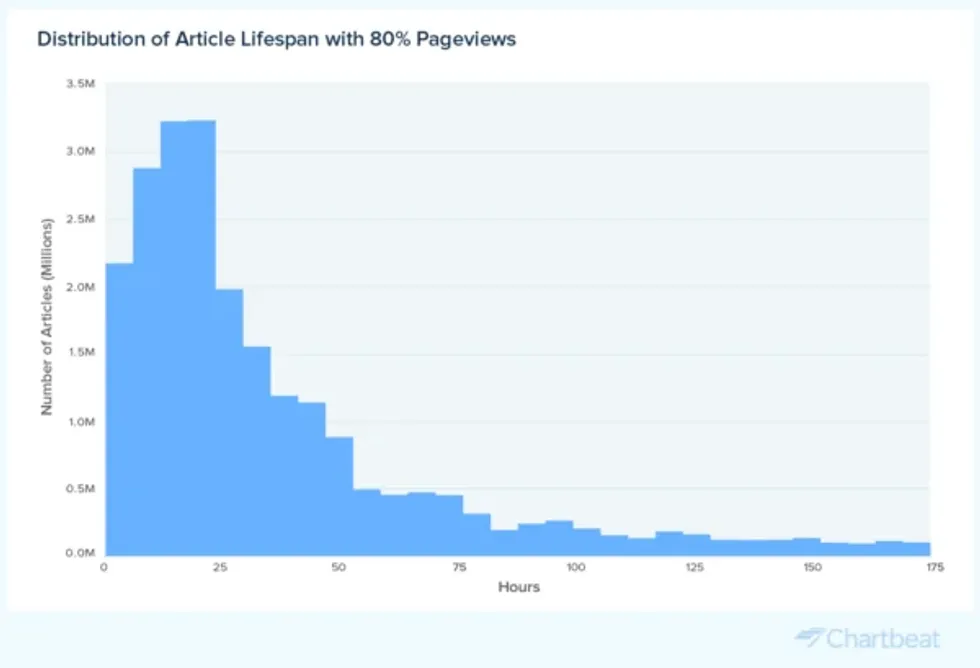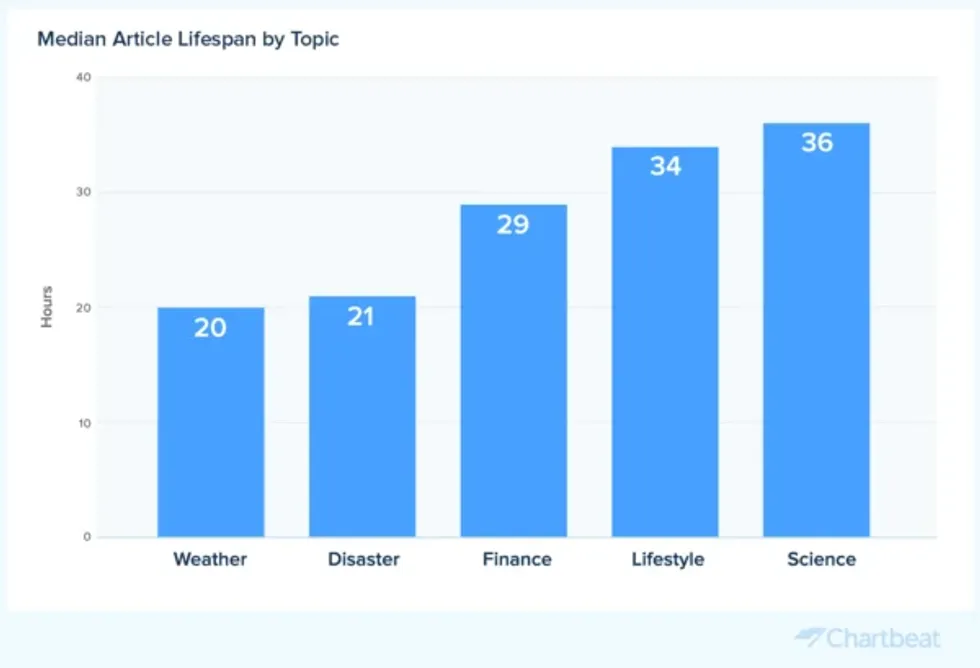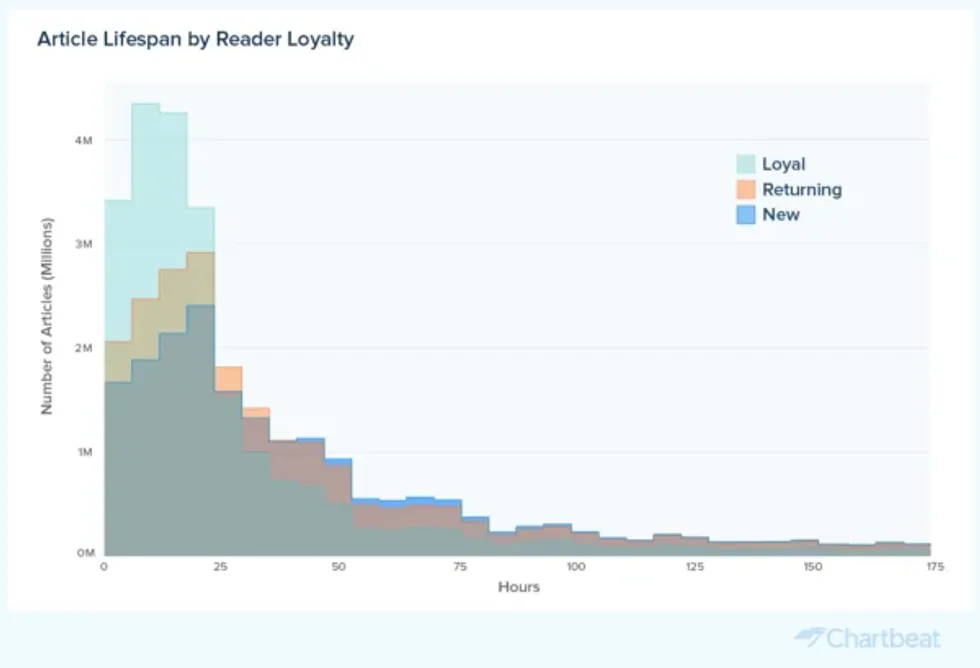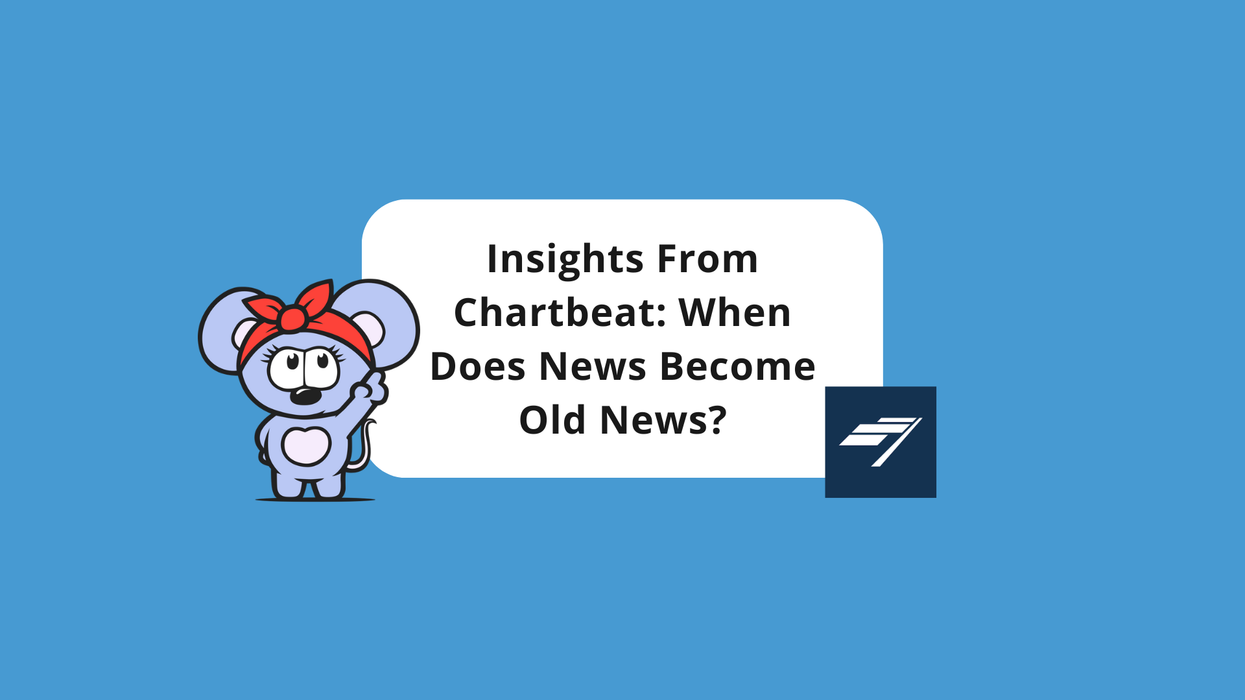This article was originally posted on the Chartbeat blog. Chartbeat’s real-time content analytics, historical dashboards, and optimization tools help the world’s leading media organizations understand, measure, and build business value from their content.
In an age where readers receive real-time notifications every time news breaks, how long can we expect a given article to hold an audience’s attention, and does it differ depending on what the story’s about or the time of day that it’s published? To find out, our Data Science team looked into the amount of time it takes an article in our network to accumulate the majority of its pageviews. For additional context on the factors that influence an article’s lifespan, we also investigated how the primary traffic source, the topic of the article, and even the time of publication affects readership. Here’s what the data shows.
A New Meaning for the 24-Hour News Cycle
Drawing from our research on how the 80/20 Rule applies to pageviews and engagement, we are defining an article’s lifespan as the time it takes to reach 80% of its pageviews over the course of the first week after publication.

When we look at the more than 27 million articles published across the Chartbeat network from June 2022 through February 2023, we see that most articles reach 80% of their pageviews within 24 hours of publication, and almost all have run their course by the 48-hour mark. While this doesn’t mean that articles won’t continue to attract traffic in the following days, it does illustrate how pivotal the first 24 hours are in terms of post-publication optimization.
How Do Referral Sources Affect Lifespan?
In addition to examining the data on a network-wide scale, we wanted to see if there was a noticeable difference in lifespan by traffic source. For instance, does an article driven by social traffic last longer than an article driven by search?
Our research shows that articles driven by internal traffic reach 80% of their pageviews quickest at around 20 hours. These are the kinds of articles that are featured prominently on a home page, and we know from past research these tend to be easily digestible formats like breaking news updates or live blogs rather than long-form reporting. Articles driven by external sources behave similarly with a median completion time of 21 hours.
On the other end of the lifespan spectrum, social-driven articles reach 80% of pageviews in 26 hours and search-driven articles take the longest with a median completion time of 36 hours. This shows that while breaking news updates are often consumed quickly by readers that are already on site, articles that optimize for search engine performance or become part of the conversation on social media experience a prolonged lifespan.
Decoding the Graphics
The first graphic in this article is called a histogram. The second, above, is a kernel density plot which you can think of as a normalized or smoothed histogram. Whereas histograms count the number of occurrences and plot them accordingly, a kernel density plot takes a histogram and normalizes the area underneath the curve to 1. This allows us to show the probability for each value as well as the range where, in this case, 80% of pageviews is most likely to fall.
What Kinds of Topics Live Longer Than Others?
Just as referral sources influence the lifespan of an article, the subject matter also plays a part. When we examine lifespan by topic, we’re not surprised to see that articles focused on breaking news and current events — weather, disaster, and sports, for example — have shorter lifespans than deeper reads in science, technology, lifestyle, and leisure. Reports on weather and disaster, for example, receive 80% of their pageviews in less than a day while articles related to lifestyle and science have a median completion time of 34 and 36 hours, respectively.

How Does Publication Time Affect Lifespan?
Our research shows that lifespan doesn’t vary much with time of publication. With one exception, articles reached 80% of their pageviews between 21–24 hours later. Articles published at 4 a.m., however, had a median lifespan of just 17 hours.
When we look at days of the week, articles published on Sunday require the least time to reach 80% of their pageviews at 22 hours and articles published on Friday take the most amount of time to reach their lifespan at 29 hours.
What About Device and Loyalty?
Lifespan is minimally affected by the device a reader uses to access an article. Articles read on desktop and mobile both reach 80% of pageviews at 24 hours, and tablet is nearly the same at 23 hours, reconfirming our overall findings that the first day is the most consequential for analyzing the behavior of an article’s audience.

When we look at lifespan by reader loyalty, loyal readers have a median time of completion of 17 hours, while returning readers clock in at 26 hours and new readers at 30 hours. As we saw earlier with internal traffic, loyal readers are on site more frequently and thus more likely to read an article soon after it is published.
The Essential Lifespan Takeaway
While some factors like topic and referral source noticeably impact the lifespan of an article, others, such as device type, have less influence. No matter where an article gets it traffic or what device it’s read on, our most important finding from this research is that if the average article gets 80% of its pageviews in the first 24 hours, publishers can’t afford to wait until tomorrow to measure and optimize their content. Waiting until the next day to look at real-time metrics and make adjustments means their efforts will impact 20% of readers at best, and that’s a stat we don’t need Data Science’s help understanding.
A Few Other Takeaways From the Research
- Articles driven by search have the longest lifespan while articles driven by internal traffic have the shortest.
- Breaking news runs its course before lifestyle and science. While there may be some advantages to incorporating more articles on longer-lasting topics, it’s important to maintain the right editorial mix and not go all in on one strategy to chase readers.
- Articles have an offsite lifespan as well. With events like elections, we’ve found that pageviews from search climb and peak on election night and then fall swiftly while social traffic remains high in the days following the event. Tubular Labs has also seen a similar long tail in their social video research, reminding us that there are opportunities to engage readers even after they leave your site.
Ready to make the most of modern publishing? Request a proposal to take your website to the next level with RebelMouse.

